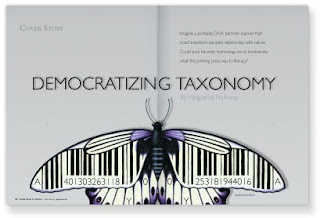Dan Janzen on a future DNA reader on Vimeo
Dan Janzen on a future DNA reader from Sam on Vimeo.
Dan Janzen imagines a handheld DNA reader in the near future which when inputted with any part of an animal (leg, scat, saliva) could tell you the species from whence it came.
For instance, dip it in a river and see what kinds of frogs and fish live upstream. Or give it a feather and see what bird has been flying by. Or lick it and see if you're coughing on account of the common cold or Ebola.
A BIO 341 blog for Bob Misley as my final project for Mycology--the science of mushrooms. All about the exciting new possibilities on the frontier of science! After all these years his crazy theories are finally being invented. Never say impossible-- it tempts those new kids.
Wednesday, December 16, 2009
Friday, December 4, 2009
International Barcode of Life: creating a searchable index of every species o... - google, techtalks, techtalk, engedu, talk, talks, googletechtalks, education - sciencestage.com Biology
International Barcode of life: DNA Handheld Decoder
Monday, November 2, 2009
Barcode of Life Initiative
In 2003, Dr. Paul Hebert at the University of Guelph in Ontario, Canada, proposed “DNA barcoding” as a way to identify species. Barcoding uses a very short genetic sequence from a standard part of the genome the way a supermarket scanner distinguishes products using the black stripes of the Universal Product Code. Two items may look very similar to the untrained eye, but in both cases the barcodes are distinct.
Until now, biological specimens were identified using morphological features. In some cases a trained technician could make routine identifications using morphological “keys”, but in most cases an experienced professional taxonomist is needed. If a specimen is damaged or is in an immature stage of development, even specialists may be unable to make identifications. Barcoding solves these problems, because non-specialists can obtain barcodes from tiny amounts of tissue. This is not to say that traditional taxonomy has become less important, but rather that DNA barcoding can serve a dual purpose as a new tool in the taxonomists toolbox supplementing his/ her knowledge as well as being an innovative device for non-experts who need to make a quick identification.
The gene region that is being used as the standard barcode for almost all animal groups is a 648 base-pair region in the mitochondrial cytochrome c oxidase 1 gene (“CO1”). COI is proving highly effective in identifying birds, butterflies, fish, flies and many other animal groups. COI is not an effective barcode region in plants because it evolves too slowly, but botanists are now close to identifying a combination of gene regions that will serve as a barcode region for plants.
Saturday, October 31, 2009
Thursday, October 29, 2009
Wednesday, October 28, 2009
Links to Information About DNA Barcoding Taxonomy
The Rockefeller "Barcode of Life" Project
The International Barcode of Life
The first generation of barcode readers will be table-top instruments that execute barcode analysis, while second generation devices will be hand-held.
Blog of Life: Links to DNA Barcode Organizations
The Ecoinformatics Revolution
Electronic Field Guides of the Future
Democratizing Taxonomy
Ontario Genomics: Democratizing Taxonomy II
Barcoding: Towards a DNA PDA
DNA barcoding works on the basis that DNA sequence diversity in short, standardized gene regions
provides a sophisticated tool for both the identification of known species and the discovery of new ones.
The event culminated with discussion of the next steps in the development of a portable DNA barcoder
and its uptake and use by government and industrial users...
Top Ten Reasons for Barcoding Life
1.Works with fragments.
2.Works for all stages of life.
3.Unmasks look-alikes.
4.Reduces ambiguity.
5.Makes expertise go further.
6.Democratizes access.
7.Opens the way for an electronic handheld field guide, the Life Barcoder.
8.Sprouts new leaves on the tree of life.
9.Demonstrates value of collections.
10.Speeds writing the encyclopedia of life.
The International Barcode of Life
The first generation of barcode readers will be table-top instruments that execute barcode analysis, while second generation devices will be hand-held.
Blog of Life: Links to DNA Barcode Organizations
The Ecoinformatics Revolution
Electronic Field Guides of the Future
Democratizing Taxonomy
Ontario Genomics: Democratizing Taxonomy II
Barcoding: Towards a DNA PDA
DNA barcoding works on the basis that DNA sequence diversity in short, standardized gene regions
provides a sophisticated tool for both the identification of known species and the discovery of new ones.
The event culminated with discussion of the next steps in the development of a portable DNA barcoder
and its uptake and use by government and industrial users...
Subscribe to:
Comments (Atom)

